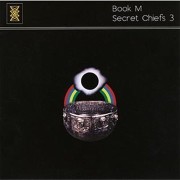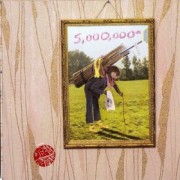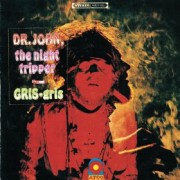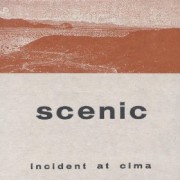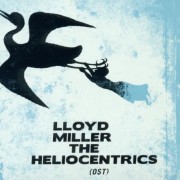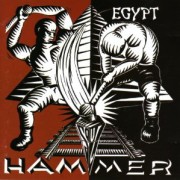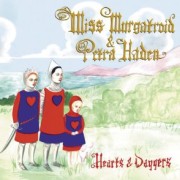40. Aram Bajakian: There Were Flowers Also in Hell
Who is Aram Bajakian? He’s been on the road with both Lou Reed (RIP) and Diana Krall. Let me repeat that: he has played guitar with both Lou Reed and Diana Krall. Quick, how many musicians do you know who are versatile enough to pull that off? It speaks volumes to hear Sweet Lou introduce Bajakian as “guitarist extraordinaire” in of the many, highly recommended clips available on YouTube.
There Were Flowers Also In Hell is a testament of Bajakian’s love affair with his instrument. The inspirations he has absorbed infuse practically every second of this recording, but the sum total is anything but reductive. This album contains multitudes, and they are original as they are exhilarating. This is not jazz, nor is it necessarily rock or blues; it’s a reflection of the mind and soul of the man who made it, like all great art must be. As such, it is also a reflection of the frenzied times we live in: the turmoil, apathy and information overload, yet it prevails as an antidote for the very urgencies it addresses.
39. Secret Chiefs 3: Book M
A lot of people worried way too much about whether or not Mr. Bungle would ever make another album after California (I know, I was one of them). Little did we know that if they had, we may never have gotten Tomahawk, or the resurgence of Secret Chiefs 3. Who? Exactly.
To put it simply, Secret Chiefs 3 are the “other” guys from Mr. Bungle. But to say that Secret Chiefs 3 are Mr. Bungle without the vocals does not even come close to describing them, or doing their remarkable music the slightest justice. On the other hand, trying to get a handle on their sound is hopeless, and I mean that in a good way. They blend a sort of surf-thrash guitar (courtesy of mastermind Trey Spruance) but remain grounded in a narcotic jazz groove (thanks to bassist and composer Trevor Dunn), with a distinctly Eastern (think Indian meets Bollywood in a cloud of opium) influence, with a healthy dose of Morricone. And then throw in the sax and violin (the great Eyvind Kang) and quickly you realize that…we’re not in Kansas anymore. Of course, we never were. Obviously anyone who is familiar with Mr. Bungle or Fantomas should lap this up, but not to worry, if you’ve never heard of any of these acts, an album like Book M is capable of satisfying anyone with unlocked ears. It’s not eccentric for the sake of being eccentric; there is most definitely a very calculated (and complicated) method to this madness. And madness never felt so fresh and funky.
38. Dread Zeppelin: 5,000,000*
An Elvis impersonator doing Led Zeppelin covers to a reggae beat? What’s not to love? Sure, it’s a joke, but it’s dread serious. And of course if there was no musical talent, it would implode on its own petard. Probably an act best appreciated live, Dread Zeppelin manage to do the near-impossible: pull off irreverent covers of sacred classic rock that are not only original, but hysterical and enjoyable (if you recoil at the idea of the opening lines of “The Song Remains the Same” delivered thusly: “A well, a well I had a dream”, stay clear; otherwise—if you have a sense of humor and tolerance for absurd—you might be hooked at first hear). And this is coming from a Led Zeppelin freak. 5,000,000* is, for me, their most consistently rewarding work, and is worth owning just for the cover of Marley’s “Stir It Up” which features “Elvis” making a fast food order fit for The King.
37. Dr. John: Gris Gris
Most people have at least heard of Dr. John, and anyone who listened to the radio back when people listened to the radio knows his hit “Right Place, Wrong Time”. But to understand why Malcolm John “Mac” Rebennack, Jr. is a legend, this is the place to start. More, it’s the place to stop, because it all begins and ends here: nothing he’s done has been as comprehensive and inimitable as his debut.
Because of the era in which it was released, and the drugs clearly accompanying its creation, this masterpiece gets described (and/or diminished) as a “psychedelic” recording. It is, but it’s more. A lot more. For starters, Dr. John deserves eternal props for managing to invoke the deepest, secret south in an L.A. recording studio (in 1967!), and he brings a vision clearly guided by personal experience and belief. But what is it? It’s a thick, boiling gumbo full of chants, incantations, whispers and cries, animal noises, exotic—or, at least, unexpected—instruments (mandolin, harpsichord) and a surreal tension that is equal parts menacing and convivial. It’s a living document of an opaque, unspoken history: Gris Grisis, by turns, unsettling, intoxicating, eerie, bizarre and triumphant.
36. Scenic: Incident at Cima
When you can describe any piece of music entirely in clichés it’s either very good or very bad. Incident at Cima is very good. Ready? It’s the soundtrack to the best movie never made. It invokes a fast and aimless drive through the desert. It is like a peyote trip in sound. It is haunting. It is unlike anything you’ve ever heard. It will remind you of so many things you like about (insert artist here, starting with Ry Cooder). It rocks. It inspires contemplation. This is music that can—and should—accompany (insert activity here). It will cause you to consider the great musicians who helped inspire it, and the great music it has helped inspire. It will broaden your horizons, especially the ones you never knew you had. Et cetera.
35. Lloyd Miller: Lloyd Miller & Heliocentrics
I believe anyone willing to listen could be quickly convinced that their world was too small without this album. Not unlike the way a great novel, movie or even a new type of cuisine will remind you that there are places and times you were unaware of, and that someone—or something—else can transport you without the use of machines or magic (or even drugs). If, understandably, that sounds a tad too precious, this is music you can put on while you meditate, do yoga, think or have sex. So there’s that. Unforced and never formulaic, this music manages to be adventurous without descending into pretense or abrasiveness: it is reminiscent of far-away times and places, but ultimately situated contentedly in the here-and-now.
34. Egypt: Soul Hammer
One slight indulgence: I know this band because I often watched them live while attending George Mason University in the early ‘90s. But their inclusion is neither nostalgic nor sentimental; I still listen to their albums and this one remains a personal favorite. Indeed, I’ve long held a fantasy that in a parallel or at least proper universe, Egypt would have broken big and so many mediocrities from that era would remain minor acts. Put another way, Soul Hammer is exactly the album Lenny Kravitz has always wanted to make, only more so.
The guitar playing throughout is crushing yet nuanced, occasionally bordering on Alice in Chains level intensity and original, and the singing is superlative (comparisons to inexplicably wealthy acts are inevitable). Egypt may have been before their time, or utterly of their time—in a good way—and simply gotten lost in the grunge-laden hall of mirrors. This is the real deal: energy to spare, virtuosity in spades, stylistically versatile and more than a little menacing. Album centerpiece “Live Like That” (which features a lift-the-lighters guitar solo) could/should have been in heavy rotation on MTV, and still should find its way into an important scene in a great movie.
33. Miss Murgatroid & Petra Haden: Hearts & Daggers
A violin/accordion duo?Really?
Yes, really. This is likely the weirdest selection on this list, but it’s also one of the most wonderful. Petra Haden (daughter of jazz bassist Charlie Haden) already gets props for making one of the most adventurous and audacious albums of the new century, a totally a capella remake of The Who’s The Who Sell Out. (Seriously.) Suffice it to say, calling this type of music an acquired taste is more than a slight understatement.
So, Hearts and Daggers, Haden’s second collaboration with Miss Murgatroid (accordionist Alicia Rose) is at once totally out there, but also, refreshingly accessible. Think Beach Boys harmonizing (with female voices) set to slightly surreal classical chamber music. Naturally, there are a whole lot of people who won’t have the ears (or stomach) for this from the get-go, but for more adventurous (and, frankly, experienced) listeners, this is a treasure waiting to be dug up. The music invokes up a dreamlike state that is neither contemporary nor particularly western, yet it could only be made today: the result is highly stylized, utterly uncompromised magic.
32. Bohren & der Club of Gore: Black Earth
The band actually calls what they do “horror jazz” which is just about right. It could almost be a Saturday Night Live (think Sprockets) skit: the band is German, there are no vocals, and the titles of the songs include “Midnight Black Earth”, “Constant Fear”, “Destroying Angels” and “The Art of Coffins”. It seems like the biggest joke except for two things: it is so obviously non-commercial (ever heard of this band? I didn’t think so), and it’s a totally original triumph.
It is dark (real dark), it is slow (real slow) and it’s definitely not daytime music. In other words, it’s perfect! Seriously, this is an album to accompany late night ruminations, or the enjoyment of a solo scotch on the rocks, or an ideal soundtrack for drifting off to sleep. This is not an album that would necessarily be in heavy rotation (unless you are a guy who wears black eyeliner) but it is the ultimate go-to album for certain occasions that only you will know about.
31. Ennio Morricone: The Thing (Original Soundtrack)
Perfection is a word that should never be used lightly, but no other word will suffice for the wonders Ennio Morricone works, scoring this film. The name Morricone is—and should be—associated with brilliance, variety and superhuman productivity, just to pick a few obvious choices. While the list of only his very best efforts is not short, his work here must be considered amongst the top tier: The Thing would be unimaginable without it. Rather than overwhelming, or distracting the action on the screen—as film scores do with distressing regularity these days—Morricone’s music exists mostly on the periphery, in the corners and inside the shadows. Its effectiveness serves an almost opposite purpose to the handful of over-the-top alien transformations: the real horror of the story lies in the tension of not knowing, the dread of isolation and the fear of being assailed by an inexplicable enemy. Morricone subtly embellishes the otherwise silent scenes, where the only sounds are Antarctic winds, silence and darkness. As the paranoia increases, strings are plucked like raw nerves, while stark, almost soulless keyboard drones mirror the growing desperation: the music exists as a wind chill factor, making everything colder and more forlorn than it already is.


